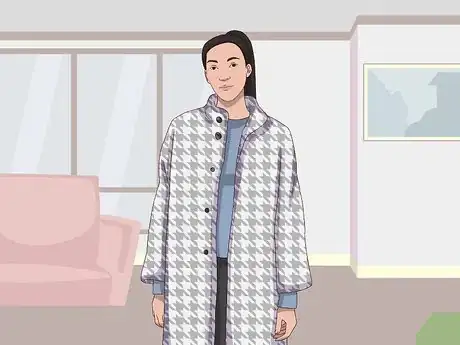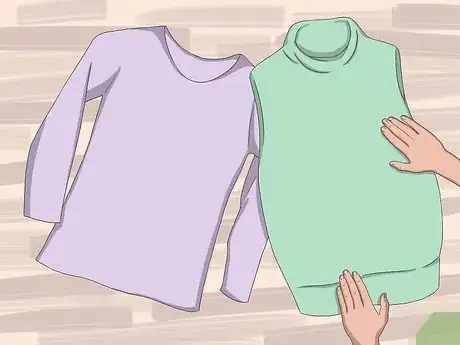This article was co-authored by Kathi Burns, CPO®. Kathi Burns is a board certified Professional Organizer (CPO) and Founder of Organized and Energized!, her consulting business with a mission to empower people to master their environment and personal image by assisting them in taking control, making change and organizing their lives. Kathi has over 17 years of organizing experience and her work has been featured on Better Homes and Gardens, NBC News, Good Morning America, and Entrepreneur. She has a BS in Communication from Ohio University.
There are 11 references cited in this article, which can be found at the bottom of the page.
This article has been viewed 242,441 times.
Layering clothes well creates a chic, sophisticated look for the wearer. Additionally, layering is quite practical, allowing a person to be ready for a wider range of temperatures without having to change an outfit completely. Doing this properly can be a daunting task for the inexperienced. However, with a little knowledge and practice, you can learn to layer your clothes like a pro.
Steps
Understanding Layering Basics
-
1Choose the right inner layers. These are everything that lies against your skin and is generally not visible in your final outfit. At bare minimum, this typically includes underwear and a bra if you wear one. The inner layer may also include undershirts, tank tops, camisoles, and long underwear. As long as they've been washed, it doesn't matter what shape your inner layers are in.
- If you layer right and cover them completely, nobody should be able to see them. Unlike the rest of your outfit, it is ok if these items have stains or holes.[1]
- On the other hand, if you're planning a sheer or risque outfit where you do want to show some of what would normally be your inner layers, make sure that they are pristine and match the rest of your outfit.
-
2Wear outer layers that can be easily added or removed. Your outer layers will be things like jackets, coats, sweaters, scarves, or gloves depending on the weather. The practical side of layering is meant to keep you comfortable in the face of variable temperatures. Ideally, a well-layered outfit is one that you can modify in public without embarrassment. Since your outer layers are the ones you'll be switching most often, wear items that are loose and easy to slide into and take off effortlessly.Advertisement
-
3Make sure your outfit works both as a whole and minus an outer layer or two. This is especially important in cool weather where you're likely to spend a lot of time bundled up in an extra thick outer layer and without it completely. If your outfit doesn't look quite right with your coat or the coat clashes completely, consider reevaluating your layer choice.
-
4Use the right amount and combination of colors. Coordinating wardrobe colors properly can be a tricky process that takes some practice to get right. However, there are a few quick rules to keep in mind.
- Don't mix neutrals that are similar in brightness. The basic neutrals when it comes to fashion are black, browns, grays, and navy blue. While an outfit with navy and light tan or black and light gray can work, navy and black or chocolate brown and gunmetal gray are much more difficult to pull off.[2]
- Balance the colors in an outfit. When you're first learning to coordinate colors, it's best to stick with only two to three per outfit. However, as you begin to put together more complicated layered looks, feel free to use as many as you can pull off. A good rule of thumb for multicolored outfits is to match a color in one garment with the same shade somewhere else on your outfit. For example, a bright multicolored floral print dress is simple to pull off with a jacket matching one color, shoes that match another, a belt that matches yet another, and/or leggings that match yet another still.
-
5Avoid multiple bold patterns that overlap. You can wear multiple big patterns in one outfit, but it's best to spread them out. For example, if you're wearing a houndstooth jacket, your sweater directly underneath should ideally be a solid color. However, your tie or your shirt underneath the sweater (not both) could be a different pattern.
- Very small, subtle patterns without much contrast (such as most herringbone) are largely exempt from this rule.[3]
-
6Match each piece one at a time. Starting from either your outermost or innermost visible layer, match each garment. Lay them out on a flat surface to figure out what they look like together in your chosen arrangement. Then, check them both against the next possible item. Keep going until you have a complete outfit.
Maintaining Your Silhouette
-
1Wear inner and base layers that hug the skin. One of the aspects of layering that most people find daunting is avoiding outfits that look too bulky. The easiest way to do this is to keep bulky garments on the outside and thin, lightweight ones closer to your skin. If you are working with middle layers, try to include them in this thickness gradient.[4]
-
2Pick items that are varying lengths. When your clothes are all the same length, they are prone to looking too puffy. A jacket, sweater, and shirt that are all different lengths will help to avoid this and create a much slimmer style.[5]
- This is less important if you are layering very thin material or would like to add bulk to a thinner frame.
- Traditional or conservative style rules assert that you should layer with your shortest hem on the inside to your longest hem on the outside. For example, an outfit layered this way would be mid-length sweater overtop of a shorter shirt with a longer jacket on top.[6]
- Other fashion experts eschew this advice. Instead, they suggest that you simply aim for contrast between items instead of sticking to a set length gradient. One example of this type of layering would be a long untucked shirt underneath a shorter sweater topped off with an even longer coat.[7] Another would be a short jacket overtop a maxi dress.
-
3Balance loose and baggy cuts. Using different volumes is another way you can avoid a bulky outfit, even while wearing some thick or loose items. A billowing blouse will look great over skinny jeans, while a tight top will complement a ruffled skirt. Likewise, a tight jacket can look good overtop a flowy dress, while a large bulky coat will pop over a short skinny one.
Layering in Cool Weather
-
1Wear an inner layer that is insulating but breathable. A well-insulated layered outfit will likely make you sweat a little at some point, no matter how cold the weather may be. To stay comfortable and clean, you will need inner layers that are both insulating and will manage the resulting sweat. Silk and wool undergarments will keep you warm while whisking away moisture.[8]
-
2Choose other cold weather fabrics for the rest of your outfit. In addition to wool, your visible layers may be a combination of a variety of insulating fabrics, such as flannel, corduroy, thick cottons, and cashmere.[9] If you wear leggings, wool or leather will keep you much warmer than nylon.
-
3Match your accessories. Much more so than any other climate, your accessories will be practical. Gloves, scarves, and hats will all help to trap warmth. Follow the same rules with your practical accessories as you would the rest of your layered outfit.
- Layered scarves are a chic way to keep warm. One popular look is to tie one scarf more tightly around your neck while letting a second hang loose.[10]
-
4Look to others to figure out what works. Cold weather layering can be much more complicated than layering in other seasons. Until you get the hang of it, try building outfits based on what you've seen look good on others.
- A classic feminine winter look is to wear insulating leggings under a short skirt paired with a scoop neck sweater overtop a collared shirt. Top it off with a peacoat either the same length as or an inch or two shorter than your skirt. Matching gloves and a scarf can be added for extra protection.
- A more masculine outfit for the cold is a simple blazer over a sweater with a collared shirt as the innermost visible layer.[11] Pair this look with dark slacks, and you have an outfit appropriate for most situations. Wear a matching long overcoat, gloves, and/or a scarf if the weather demands it.
Layering in Warm Weather
-
1Keep a lightweight outer layer item with you. This can be a cardigan, light sweatshirt, windbreaker, or some other garment that won't look out of place in warm weather. When the temperature climbs outside, people often crank up their air conditioners to compensate. Additionally, in many areas the temperature can drop dramatically overnight. Avoid getting goose bumps because you dressed for only the heat.
-
2Stick to warm weather fabrics. These are textiles that are lightweight and less insulating than cold weather fabrics. Some good examples to keep in mind are linen, poplin, and light cottons. You want to make sure that all layers whisk away sweat and promote its evaporation.[12]
-
3Try to avoid visible under layer lines. Because warm weather clothing tends to be lighter and thinner than winter clothing, it also tends to be much more transparent.
- Gray inner layers will be less visible under light clothing than white.[13] Matching your inner layer with your skin tone will also help to cut down on visibility.
- When done right, sheer outwear can also be on-trend. A good rule of thumb is to match the sheer piece to the main color of the garment visible underneath.
-
4Keep it simple. In general, there is much less of a reason to layer in the warmer months. While the layered look can be chic, too much may make you stand out in the wrong way.
- An unbuttoned shirt over a t-shirt or tank top is a good conventional causal look. Just remember to keep that lightweight outer garment on hand if you need it.
- Keep your sleeves as short as possible while still being appropriate for the occasion. Sleeves can dramatically increase an outfit's heat retention. One trendy layering option is to wear a sleeveless vest over a longer-sleeved shirt.[14]
Expert Q&A
Did you know you can get expert answers for this article?
Unlock expert answers by supporting wikiHow
-
QuestionHow do you color coordinate an outfit?
 Natalie TincherNatalie Tincher is the Owner and Principal Style Strategist of BU Style. With more than 10 years of experience, Natalie specializes in personal styling to reflect clients’ individuality, confidence, and comfort. In 2019, she was named the Global Head of Styling for Bloomberg Television. Natalie is certified in Image Consulting through the Fashion Institute of Technology. She regularly shares her expertise with corporate groups at major financial institutions, media companies, and news outlets including: Time Out New York, Refinery 29, and NBC News.
Natalie TincherNatalie Tincher is the Owner and Principal Style Strategist of BU Style. With more than 10 years of experience, Natalie specializes in personal styling to reflect clients’ individuality, confidence, and comfort. In 2019, she was named the Global Head of Styling for Bloomberg Television. Natalie is certified in Image Consulting through the Fashion Institute of Technology. She regularly shares her expertise with corporate groups at major financial institutions, media companies, and news outlets including: Time Out New York, Refinery 29, and NBC News.
Style Strategist & Wardrobe Specialist
-
QuestionHow can I wear layers without looking bulky?
 Kathi Burns, CPO®Kathi Burns is a board certified Professional Organizer (CPO) and Founder of Organized and Energized!, her consulting business with a mission to empower people to master their environment and personal image by assisting them in taking control, making change and organizing their lives. Kathi has over 17 years of organizing experience and her work has been featured on Better Homes and Gardens, NBC News, Good Morning America, and Entrepreneur. She has a BS in Communication from Ohio University.
Kathi Burns, CPO®Kathi Burns is a board certified Professional Organizer (CPO) and Founder of Organized and Energized!, her consulting business with a mission to empower people to master their environment and personal image by assisting them in taking control, making change and organizing their lives. Kathi has over 17 years of organizing experience and her work has been featured on Better Homes and Gardens, NBC News, Good Morning America, and Entrepreneur. She has a BS in Communication from Ohio University.
Image Consultant
References
- ↑ http://www.artofmanliness.com/2013/02/21/how-to-layer-clothing-men
- ↑ http://www.puttingmetogether.com/2013/01/wardrobe-from-scratch-part-2-choosing.html
- ↑ http://effortlessgent.com/patterns-101-all-you-need-to-know-about-wearing-mixing-and-matching-patterns
- ↑ https://www.dmarge.com/how-to-layer-clothes-men
- ↑ http://www.coupons.com/thegoodstuff/4-easy-ways-to-layer-winter-clothing
- ↑ http://www.artofmanliness.com/2013/02/21/how-to-layer-clothing-men/
- ↑ http://www.coupons.com/thegoodstuff/4-easy-ways-to-layer-winter-clothing
- ↑ http://www.realsimple.com/beauty-fashion/clothing/how-layer-clothes
- ↑ https://www.dmarge.com/how-to-layer-clothes-men
- ↑ http://www.coloradoan.com/story/mind-body/2015/10/28/winter-accessorizing-101/74738250/
- ↑ http://outfitideashq.com/cheat-sheet-fall-and-winter-layering-formulas-for-men/
- ↑ https://www.dmarge.com/how-to-layer-clothes-men
- ↑ http://effortlessgent.com/qa-whats-the-best-undershirt-under-a-dress-shirt
- ↑ http://www.cosmopolitan.com/style-beauty/fashion/advice/a7115/how-to-layer-in-summer
About This Article
To layer clothes in cold weather, start by wearing a form fitting inner layer that’s insulating but breathable, like a silk or wool undergarment. Next, choose other cold weather fabrics, like flannel, thick cotton, or cashmere, for your shirt or sweater. Then, select an outer layer that can be easily added or removed depending on the temperature, such as a jacket or coat. Finally, add accessories like scarves, gloves, or hats that complement the rest of your outfit. For more tips, like how to coordinate the colors of your outfit, read on!










































































